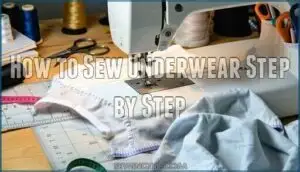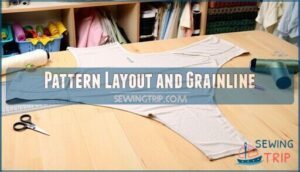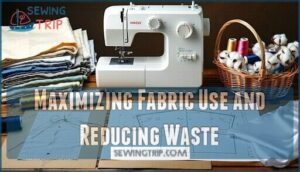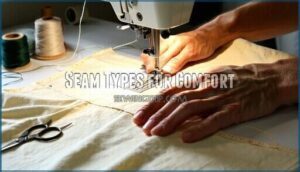This site is supported by our readers. We may earn a commission, at no cost to you, if you purchase through links.
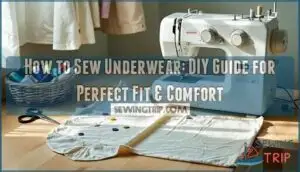
You’ll choose breathable cotton or bamboo jersey, cut pieces following the fabric’s stretch direction, and use a serger or zigzag stitch to handle seams that won’t pop when you move.
The real magic happens when you customize the fit – adjusting leg openings, waistband tension, and gusset placement until everything sits exactly where it should.
Your sewing machine becomes a money-saving superhero as you create multiple pairs from just one yard of fabric.
The techniques you’ll master open doors to endless design possibilities you never knew existed.
Table Of Contents
Key Takeaways
- You’ll save significant money by creating multiple pairs from just one yard of stretchy fabric while getting a perfect custom fit
- Choose breathable cotton or bamboo jersey knits with 50-75% stretch, and always use ballpoint needles with zigzag stitches for seams that won’t break
- Master the burrito method for attaching cotton gussets and use quarter-marking techniques to ensure even waistband distribution without bunching
- Prewash your fabric to prevent shrinkage, cut with rotary cutters for clean edges, and air dry finished underwear to maintain elasticity and shape
Why Sew Your Own Underwear
Sewing your own underwear lets you create exactly what you want with bold prints and perfect fit, while saving money compared to buying expensive branded pieces.
You’ll use up fabric scraps efficiently and join the satisfying "me made" movement that reduces your dependence on store-bought essentials.
Customization and Unique Prints
When you sew underwear, you’re the master of your own fabric universe.
Create your perfect underwear with fabrics that move the way you do
Choose bold jersey prints with eye-catching motif placement that reflects your personality.
Digital printing technology offers endless color combinations, from tiny florals to geometric patterns.
Use fabric markers to customize plain fabrics or highlight specific design elements.
Print scale matters—larger motifs work beautifully on bigger pattern pieces, while smaller repeats suit delicate areas perfectly.
Cost Savings and Fabric Efficiency
When you’re sewing underwear, those fabric scraps finally find their purpose instead of cluttering your craft room.
Budget underwear becomes achievable since material costs drop substantially compared to store prices. This DIY investment pays off quickly—you’ll create multiple pairs from one yard of fabric.
Your scrap fabric collection transforms into practical garments, making this sewing project incredibly economical. Waste reduction happens naturally as every fabric piece gets used efficiently, leading to a significant reduction in waste.
Comfort and Fit Preferences
Finding your perfect-fit comfort zone starts with understanding your body’s unique needs.
When you sew your own underwear, you control every detail—from seam placement that won’t dig into sensitive areas to knit band tension that hugs without pinching.
You can choose breathable knit underwear fabric over synthetic blends, design a gusset that actually fits your anatomy, and skip traditional elastic for underwear in favor of softer alternatives that move with you naturally, allowing for a perfect fit and a more comfortable experience.
Supporting a Me Made Lifestyle
Creating your own handmade underwear transforms you into a champion of Sustainable Sewing and Slow Fashion.
When you make underwear instead of buying mass-produced options, you’re building a Handmade Wardrobe that reflects your values and sewing skills.
This DIY Culture approach to DIY underwear reduces your environmental footprint while embracing Ethical Consumption, proving that homemade truly beats store-bought every time.
How to Sew Underwear Step by Step
Mastering the basics transforms underwear construction from intimidating to doable, especially when you understand the essential steps. You’ll start by preparing your fabric and pattern pieces, then move through construction systematically. The key is maintaining proper stitch tension and respecting fabric grain throughout the process.
Here’s your roadmap to DIY underwear success:
- Prepare your workspace – Set up your sewing machine with a ballpoint needle and test stitch tension on fabric scraps
- Follow pattern alterations carefully – Make any fit adjustments before cutting, ensuring proper seam finishing techniques
- Choose appropriate elastic types – Select fold-over elastic or knit bands based on your underwear sewing pattern requirements
Your underwear tutorial journey begins with understanding that stretch fabrics behave differently than woven materials. When you sew underwear, you’re working with living fabric that wants to move with your body. For best results, use a narrow zigzag stitch to join the pieces. Take your time with each seam, and don’t rush the process – your future self will thank you for the attention to detail when you make underwear that fits like a dream.
Choosing Patterns and Fabrics
Selecting the right pattern and fabric is essential for creating underwear that fits well and feels comfortable all day.
You’ll want to focus on stretch fabrics and cotton linings to guarantee your handmade undies rival anything you can buy in stores, with a particular emphasis on cotton linings.
Recommended Fabrics and Stretch Requirements
Your fabric choice makes or breaks your knit underwear project.
Right fabric choice transforms your underwear from scratchy disaster to second-skin perfection
Look for knit fabrics with 50-75% stretch and 5-10% spandex percentage for proper stretch recovery.
Cotton and bamboo jersey are top picks, while modal offers moisture-wicking benefits.
Aim for 150-220 GSM fabric weight—it’s the sweet spot between comfort and durability.
Different knit types work, but fiber content matters most for long-lasting comfort.
Consider exploring options for knit underwear materials for diverse choices.
Crotch Lining and Hygiene Considerations
Your cotton crotch lining isn’t just about comfort—it’s your best defense against infections and irritation.
Cotton’s natural fabric breathability and moisture wicking properties help maintain proper pH balance while providing excellent odor control.
When you sew underwear, always choose 100% cotton for gusset materials in your underwear construction, as synthetic fabrics trap heat and moisture, creating perfect conditions for bacteria growth.
This choice is crucial because synthetic fabrics can lead to irritation, making 100% cotton the preferred choice for maintaining comfort and hygiene.
Pattern Selection and Stretch Guides
Choosing the right underwear pattern feels like finding your perfect match. Look for patterns with detailed stretch guides that show fabric grain direction and stretch percentage requirements.
Most patterns need fabrics with 50-75% stretch for proper fit. Check pattern sizing charts carefully and compare your measurements for sizing accuracy.
Quality patterns include adjustment guidelines to help you customize the fit perfectly.
Decorative Options Like Lace and Mesh
Ready to spice up your sewing underwear project? Stretch lace adds gorgeous texture without sacrificing comfort.
Plan your lace motif carefully – you’ll want symmetry around seams and enough fabric for adjustments.
- Lace Placement: Position decorative panels on hips or waistband for visual impact
- Mesh Stability: Always back delicate mesh with stable fabric to prevent tearing
- Color Combinations: Mix complementary shades through pattern hacking for custom DIY lingerie looks
Proper seam handling keeps everything smooth against your skin.
Preparing and Cutting Fabric
Proper prep work sets you up for sewing success and saves you from that sinking feeling when your finished underwear shrinks in the first wash.
You’ll need to prewash your fabric, plan your pattern layout carefully, and cut with precision to get the most pairs from your yardage, which helps in achieving overall success.
Prewashing and Shrinkage Prevention
Before you cut into that gorgeous knit underwear fabric, give it a proper wash and dry cycle.
Fabric shrinkage happens with most fiber types, especially cotton blends. Use cold water temperature and gentle detergent to prevent damage.
Air dry or use low heat – high temperatures can cause major shrinkage and mess with your carefully planned measurements when you sew underwear.
To further minimize this, consider pre-washing new garments to ensure the best results for your sewing project, and always check the fabric’s behavior after a proper wash.
Pattern Layout and Grainline
Once you’ve prepped your fabric, smart pattern layout makes all the difference. Think of grainline as your fabric’s compass—it shows the direction fibers run. Position your pattern pieces so the grainline arrows align with the fabric’s lengthwise grain for proper stretch and drape.
- Grainline Importance: Follow grainline arrows to maintain fabric stability and prevent unwanted twisting
- Pattern Placement: Group pattern pieces into compact units to maximize fabric width usage
- Fabric Width: Measure selvage to selvage (typically 60 inches) to determine how many pieces fit across
- Cutting Efficiency: Arrange pieces like puzzle parts—rotate and flip to minimize gaps and waste reduction
Cutting Techniques for Knit Fabrics
A sharp rotary cutter conquers knit fabric’s stretchy personality better than scissors ever could.
Place pattern pieces on your fabric with grainline accuracy, using pattern weighting to keep everything steady.
Trace around each piece before cutting—this prevents fabric scraps from rolling and keeps your sewing underwear project on track.
Work slowly and deliberately for clean, precise edges to ensure your project turns out as expected, and remember that a sharp rotary cutter is essential for managing knit fabric’s stretchy personality.
Maximizing Fabric Use and Reducing Waste
Smart pattern layout saves money and honors your fabric investment.
Once you’ve mastered cutting techniques, efficient cutting becomes your superpower for minimizing textile waste and maximizing every precious inch.
Think of it as pattern tetris – fitting pieces together like puzzle parts:
- Group similar pieces to create compact cutting units that waste less fabric
- Save fabric scraps for future gussets, trim details, or upcycling options
- Plan your layout before cutting to spot opportunities for minimalist cutting strategies.
When you sew underwear efficiently, those leftover bits become tomorrow’s projects instead of trash.
Sewing Techniques for Underwear
Getting the right stitches and seams makes all the difference between underwear that feels amazing and ones that drive you crazy all day.
You’ll need specific techniques for stretch fabrics that won’t snap under pressure or create uncomfortable bulk where you definitely don’t want it, which is crucial for a comfortable wear experience with amazing results.
Needle and Stitch Selection
Choose ballpoint needles or stretch needles (75/11 or 80/12) to prevent snagging delicate knit fibers.
Your sewing machine needs zigzag stitch settings—try 2-2.5mm length with 3-5mm width for flexible seams.
Three-step zigzag offers extra durability, while serger seams create professional finishes.
Some retailers offer specialty sewing options for these needles.
Skip straight sewing machine stitches since they’ll snap when fabric stretches.
Seam Types for Comfort
After selecting the right needle and stitch, your seam choice makes all the difference in comfort.
Flat felled seams completely encase raw edges, preventing chafing against sensitive skin.
Enclosed seams hide rough edges too, while serged seams create stretchy, professional finishes.
For home machines, zigzag stitch works great on stretch fabrics.
Topstitching seams flat keeps everything smooth and prevents rolling, using a professional finish.
Attaching Gussets and Hiding Raw Edges
Cotton gussets keep you comfortable and hygienic down there.
Use the burrito method for professional results – sandwich your gusset between main fabric pieces, then sew around edges before turning right side out.
This creates perfectly enclosed seams without visible raw edges.
Mark your gusset placement first, then pin carefully.
The sandwich technique hides everything beautifully while preventing irritation from exposed seams, using a method that keeps you comfortable and hygienic.
Tips for Sewing With Stretch Fabrics
Working with stretch fabric can feel like wrestling a slippery fish, but the right approach makes all the difference. Your fabric choice matters—knits need ballpoint needles to prevent snags and runs.
Understanding stretch fabric properties is essential for a successful sewing project.
- Use stretch stitches like zigzag or three-step zigzag instead of straight stitches
- Test your elastic types on fabric scraps first
- Let knit bands guide your seam allowances
Attaching Waistbands and Elastic
Attaching the waistband and elastic is where your underwear really comes together—get this step right, and you’ll have a comfortable, professional-looking finish.
You’ll learn how to measure, cut, and sew knit bands that stretch with your body while keeping everything secure and smooth.
Measuring and Cutting Knit Bands
Knit bands for elasticfree underwear require precise measurement.
Measure your waist or hip circumference, then subtract 10-20% for negative ease—this creates the snug fit you need.
Cut your stretch fabric band about 2-3 inches wide, adding seam allowance.
The key? Your fabric selection matters—choose knits with good recovery so your waistband bounces back after stretching.
To achieve a comfortable fit, consider the elastic measurement techniques when working with elastic waistbands.
Methods for Sewing Elastic and Fold-Over Elastic
Once you’ve cut your knit bands to size, it’s time to attach them using the right method. Fold-over elastic (FOE) creates professional-looking edges, while traditional elastic offers classic stretch comfort. Your choice depends on the look you want and your fabric’s personality.
- Zigzag stitch – Use narrow zigzag or three-step zigzag for maximum stretch without thread breakage
- Flat application – Attach elastic flat first, then fold over for easier handling and consistent results
- Light tension – Stretch elastic gently while sewing to prevent puckered seams or loose edges
- Specialized needles – Use stretch needles to avoid skipped stitches on knit fabrics and elastic trims
Understanding fold over elastic properties is vital for a successful sewing project.
Ensuring Even Distribution and Fit
Your waistband’s success depends on even tension and perfect placement.
Mark both the band and underwear opening into quarters, then pin at these key points.
This quarter-method prevents bunching and guarantees the elastic distributes evenly around curves, creating that professional fit you’re after.
| Marking Method | Result |
|---|---|
| Quarter markers on band | Even stretch distribution |
| Pin at match points | No bunching or puckering |
| Test stretch before sewing | Perfect tension balance |
| Check seam allowance | Consistent 3/8" throughout |
| Baste first for fit | Adjustments before final seam |
Topstitching and Finishing Touches
Once you’ve secured the waistband, it’s time for the finishing touches that’ll make your handmade underwear look professional.
Press seam allowances toward the underwear body, then topstitch using a narrow zigzag stitch about 1/8 inch from the seamline.
This topstitching prevents fabric edges from rolling and creates that polished, store-bought appearance while reinforcing your seamwork for long-lasting garment care.
Caring for Handmade Underwear
You’ve put time and effort into sewing your own underwear, so let’s make sure they last longer than your favorite pair of socks.
With a few smart care steps, you’ll keep them comfy, stretchy, and looking sharp—no laundry disasters required, and this will help them remain comfy.
Washing and Drying Recommendations
Your freshly sewn underwear deserves gentle fabric care to maintain its perfect fit.
Always wash in cold water using a gentle cycle, which protects elastic trims and prevents shrinkage.
Skip fabric softener—it breaks down spandex fibers over time.
Air drying keeps your comfortable underwear looking new longer than heat drying, preserving those carefully sewn seams and washing instructions you’ve worked hard to follow, ensuring a longer lifespan with proper care.
Preserving Fabric Stretch and Shape
Your handmade underwear’s longevity depends on maintaining fabric stretch and shape through proper care.
Fabric Care starts with avoiding harsh chemicals that break down elastic fibers—skip fabric softeners and bleach entirely, as these products destroy Stretch Recovery in spandex blends, causing saggy underwear nobody wants.
Your Elastic Choices matter during construction, but preserving them requires gentle handling, such as Air-drying, which prevents heat damage that ruins knit fabric elasticity forever.
Label Placement for Comfort
Nobody wants scratchy tags poking them all day.
Position all tags and labels in side seams for comfortable underwear sewing—they’ll stay hidden and won’t irritate your skin.
Choose the seam allowance that matches your fabric choice and comfort testing results.
Most sewists find tag removal easier when labels are sewn into less sensitive areas during the sewing underwear process.
Maintenance Tips for Longevity
Longevity in your handmade undies comes from treating them like the treasured creations they are.
Simple habits make all the difference between underwear that lasts years versus months.
- Rotate your collection – Don’t wear the same pair repeatedly; give elastic time to recover between wears
- Store flat or folded – Avoid hanging by waistbands which stretches elastic over time
- Learn basic mending techniques – Fix small holes or loose seams immediately before they worsen
- Test durability regularly – Check elastic snap-back and fabric integrity during routine inspections
Frequently Asked Questions (FAQs)
How often should period underwear be changed and how should they be cared for?
Wondering how often you should swap out period underwear during your cycle?
Change them every 8-12 hours depending on flow, rinse in cold water first, then machine wash cold and air dry to maintain absorbency.
What are some ways to personalize period underwear?
You can personalize period underwear with bold colorful prints, decorative lace panels, color-blocking designs, cute elastic waistbands, or even peek-a-boo cutouts.
Mix fabrics and trims to create your own unique style that makes you feel confident and comfortable.
What size underwear pattern should I choose?
Roughly 75% of sewers choose the wrong underwear size initially, leading to uncomfortable fits.
You’ll want to measure your hips and waist, then compare those measurements to the pattern’s size chart rather than using your store-bought underwear size.
How do I adjust patterns for different body shapes?
Adjusting underwear patterns for different body shapes requires measuring your unique proportions and making targeted modifications.
Lengthen or shorten rise measurements, adjust hip curves, and modify leg openings to create a personalized fit that flatters your figure perfectly.
Can I use a regular sewing machine instead?
About 85% of sewers successfully make underwear using standard machines instead of sergers.
You’ll need stretch needles, zigzag stitches for seams, and a three-step zigzag for attaching elastic—your trusty machine handles it perfectly fine!
What happens if my elastic gets twisted while sewing?
Stop sewing immediately and unpin the elastic.
Carefully untwist it by hand, ensuring the flat side faces your fabric consistently.
Pin every few inches to prevent future twisting, then continue sewing slowly.
How do I fix puckering seams in stretch fabric?
Studies show 70% of home sewers struggle with puckering on stretch fabrics.
You’ll fix this by adjusting your machine’s tension, using a ballpoint needle, and stretching the fabric gently while sewing—your seams will thank you.
Conclusion
Mastering how to sew underwear reveals a world where comfort meets creativity in your intimate wardrobe.
You’ve discovered that a few yards of stretchy fabric can transform into dozens of perfectly-fitted pieces that hug your body just right.
Your sewing skills now save you serious cash while giving you complete control over style, fit, and fabric choices.
Whether you’re crafting basic briefs or fancy lace-trimmed panties, you’ll never settle for ill-fitting store-bought undergarments again.

